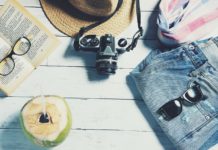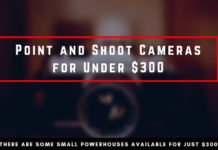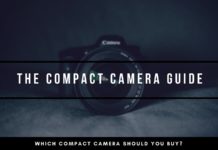I think it is no secret that I am a strong advocate for mirrorless cameras. They are already better than DSLRs and as evidence and statistics suggest, they will be also stronger selling than DSLRs in the near future. If You are interested in photography and are looking for a new camera, then mirrorless is the way to go. In this guide, I want to present the best mirrorless cameras for beginners.
Mirrorless Cameras for Beginners
Now You might ask Yourself, what is so special about mirrorless cameras for beginners?
Since I already wrote a guide about the best street photography cameras, You could also head there and have a look if You find a suitable camera. But this guide is specifically made for beginners, that are just getting into photography and want to have the best camera in their hand, to learn this beautiful art form.
The Price
In this guide, I focus on cameras that are not too expensive and more or less in the price range of $500. This will make it easier to get into photography without too much of a financial commitment. You can buy these cameras easier and also sell them again without much of a loss if You find out that photography isn’t a long-term interest of Yours.
If You are dedicated to save some money, then You may also be interested in my guide about point and shoot cameras for under $200.
Easy To Use
The cameras are also easy to use, offering forms of automatic modes without being too complex at first. On the other hand, if You wish to dig deeper, they offer You all the freedom every other “pro” camera can offer You.
Great Image Quality
Don’t worry about image quality as well. The presented mirrorless cameras for beginners are great when it comes to image quality while being relatively low cost. Modern cameras regularly feature more than 24 Megapixels, which is more than enough to print photographs that are fit to look beautiful on Your home’s walls.
Built-in Features
The presented cameras already contain a load of great features that make Your pictures look like they are edited by a professional. This can be preset styles that make Your photographs look differently like increasing the contrast or turning them black & white. Without further tinkering in Photoshop, the pictures that are taken by the camera already look great. The cameras also have built-in flashes which can be helpful at night or in more difficult darker areas.
Once again, the features make Your life easier at the beginning, but if You wish to use the potential of the camera differently and for example want to explore and work with the RAW-Files, then the cameras allow You to do so.
Are there any limitations for Beginner Cameras?
If You are worried that the following mirrorless cameras might be limiting You, then I assure You that the options and features are only a further assistance. The more You learn and gather experience on Your own, You can turn off the support tools of Your camera and explore the world the way You want.
Beginner Mirrorless Cameras come with features that make Your life, in the beginning, easier, but they don’t limit Your creative freedom once You progress further in Your photography endeavor.
The Best Mirrorless Cameras for Beginners
Sony Alpha A6000
Let’s start the list with my absolute recommendation for the best mirrorless camera for a beginner.
The Sony A6000 is very small, easy to use and offers a great image quality. The camera also comes with an interchangeable lens design, so You are free to use other lenses, although I would recommend You to go with the kit-lens and later on invest in a new lens when You are experienced and know which lens You might need.
For easy connection, the Sony A6000 comes with built-in Wi-Fi to make the image transfer to other devices easier. The battery life of this camera is also a huge plus.
The menu is very intuitive and easy to understand, even if You hadn’t a camera in Your hands before. In combination with its very inexpensive price, this camera is my definite recommendation when You are interested in photography and want to learn this craft.
License
Features
Features
Templates
PRO
Excellent Image Quality
Interchangeable Lenses
Wi-Fi
CONTRA
May Be too Small
Get The Camera Here
Ricoh GR II
Hands off, I am a huge fan of the Ricoh GR II and it is one of the best cameras for Street Photography available. It is very easy to use with one wheel being for the aperture and different automatic modes that You can choose from.
The RicohGR II doesn’t come with an interchangeable lens design but features a 28mm full-frame equivalent lens. Although the RicohGR II is so small and compact that You can easily carry it in Your jacket pockets, it sports an APS-C sensor.
I recommend this camera if You are mostly interested in Street Photography and want to try out a camera that is specifically made for this genre. The camera might not be very flexible, but for Street Photography it is one of the best cameras available.
License
Features
Features
Templates
PRO
Excellent Image Quality
APS-C Sensor
Very Compact
CONTRA
No Viewfinder
Get The Ricoh Here
Panasonic Lumix G7
Are You looking for a mirrorless camera that is more versatile and offers more than simple photography? Then the Lumix G7 is a great choice, as it features a 4K video mode. In addition to photography, with this camera, You can also explore the world of videography.
To control the aperture and shutter speed, the Lumix G7 comes with easy dials that let You control the camera settings directly. This makes it very easy for You to understand the dependencies of the aperture, shutter speed, and ISO directly since You are seeing the results in real-time.
Aside from videography, do You want to photograph Your kids or friends at sports events? Then this mirrorless camera is a great choice as well and the auto-focus is very well for this kind of photography.
To make Your life easier, I have linked You the camera including the 14-42mm kit lens below.
License
Features
Features
Templates
PRO
4K Video Mode
Easy Dials
Great Auto-Focus
CONTRA
Low Light Performance
Get The Camera & Lens
Olympus EPL-8
Not always do I need the technical details of a camera to convince me to buy it. Sometimes it is a combination of a neat design and technical prowess with a sense of understatement. This exactly where the Olympus EPL-8 comes into play.
The camera design is very minimal and leaned towards a classic film camera. When it comes to the actual quality and power, the camera isn’t classic but has a lot of great modern features.
One of the best features would be the 3-axis in body image stabilization. Let me explain in short, why this is a great feature. Normally we say that we shouldn’t reduce the shutter speed slower as the reciprocal of the focal length. Meaning that with a 50mm lens we shouldn’t shoot slower than 1/50s, or else the picture will be shaky and blurry. With the in-body image stabilization though, You can confidently go below this limit and still get perfectly sharp images.
Do You want to do a lot of landscape photography and like to have at least a slight blur of rivers or the ocean? Then this is possible with this camera and a short focal length to a certain degree. Of Course, the results are a lot better when using a tripod, but if You are on a hike and want to spontaneously shoot a stream, then this camera is a great point of entry.
License
Features
Features
Templates
Templates
PRO
Vintage Design
3 Axis Image Stabilization
Great For Longer Shutter Speeds
Tiltable Screen
CONTRA
No Viewfinder
Get The Camera here
Samsung NX-3000
The final camera on this list of mirrorless cameras for beginners is the Samsung NX-3000.
I chose this camera to close the guide because of the tiltable screen that can even turn to the front. A great choice if You are looking to shoot a lot of pictures with Your friends, or are using this camera to take videos, which it is capable in full HD.
On a further note, You can also use Your phone as a viewfinder instead of the LCD-screen. This can be helpful when setting up the camera a little farther away and You want to get the framing right.
License
Features
Features
Features
PRO
Good Resolution
HD Videos
Tiltable Screen
CONTRA
No Viewfinder
No Built-in Flash
Check the current Price
Tips for Buying a Mirrorless Camera
In this guide, I have presented to You five different alternatives of mirrorless cameras that are an excellent inexpensive way to enter the realms of photography. There are great mirrorless cameras available for less than $1000. Each camera has its own characteristic and while I have explained the best use for some, there are additional questions You should ask Yourself before buying a new camera.
I have touched this topic before and provide a more in-depth guide about what to look for in a Street Photography Camera, but to make it a little easier I want to ask You some questions and guide You to the right camera.
Which are Your personal interests?
The first question that You should ask Yourself is about your personal interests and what You are looking forward to photographing. Are You already sure in Your prospects or still unsure?
For example, if You are quite clear, that Street Photography is a focus of Yours, then the RicohGR should be Your favorite. It is small, has a short focal length and works well with an external flash.
Or do You need a camera that is more versatile?
The Sony a6000 is my top recommendation because it does everything very well. With interchangeable lenses, You can be more specific for different genres, but I will explain the different lenses a little further down this guide more specifically. Furthermore, the Sony a6000 is very capable of shooting good videos, has a fast auto-focus and works very well in low light situations. Therefore, it is a perfect start if You are not very specific about a certain genre and want an allrounder that is suitable for everything.
What features are important to You?
Together with Your personal interests, You should be clear about the features and its priorities. Do You need a camera that can shoot videos in 4K, or has a fully tiltable screen?
Often times, these features are nice to have, but if You don’t really need them then You pay a premium for features that You might not be using.
On the other hand, the RicohGR II might look very “simple” in this regard, but focus more on the essential and delivers a great image quality.
Instead of going for the camera that sounds like it has the most features, consider the camera that is more suited for Your needs and decide beforehand which features are important for Your new mirrorless camera.
Which Lens should You buy?
If You are looking to be more serious about photography, then You also are faced with the decision of buying the right camera lens. Although I have linked already options with kit lenses, that are the ideal way of starting in photography, I want also present the different focal ranges and its use.
Be aware, that camera manufacturer uses different mount systems and that not every lens is compatible with every manufacturer.
Wide-Angle Lenses (up to 28mm)
Our human eye work with a focal length comparable to 35 to 50mm. Everything below this focal length means that the subjects are further away than they appear for our eye.
Wide-Angle lenses with a range up to 28mm are widely used in landscape photography and occasionally the 28mm is also used for Street Photography. The RicohGR has the 28mm built-in and can not be changed.
This Wide-Angle lens is also good if You are often working on close ranges or in narrow spaces. For example, if You are photographing lost spaces or music concerts with a huge crowd, then the wide angle lens can be ideal to emphasize the huge crowd.
The Human Focal Length (35mm to 50mm)
This focal length is ideal for Street Photography or other photography genres where You need to photograph quickly and don’t have much time to look through the viewfinder. The advantage is, that this focal range is close to our human perception and doesn’t need much adaptation. As a beginner in photography, You will get accustomed to this range pretty quickly.
With a focal range from 35mm to 50mm, You are pretty versatile in Your subjects that You can photograph. From portraits to landscapes or Street Photography, this range works well with these genres.
The Tele-Lens (starting from 85mm)
Now we are zooming in on our subject and beginning from 85mm the subjects appear closer to the camera than they actually are. With these longer lenses, You can also get a more shallow depth of field, which can be good for portraits.
This focal length is great for wildlife, sports or portrait photography.
Which influence have Megapixels on the Image quality?

The megapixel count is one technical characteristic of cameras that is often used when describing the image quality. The more megapixels a sensor can deliver, the better the image will be – right?
Truth is, that megapixels are already at a stage where it doesn’t really matter. Digital cameras are so much advanced, that megapixels don’t make a real difference in everyday photography work.
I had pictures in exhibitions that had fewer than 12 Megapixels after cropping the picture and it didn’t make any difference.
The only advantage that a lot of Megapixels have are, that You have some more freedom to crop the photograph afterward. Other than that, it doesn’t make a real difference if a camera can shoot at 16 Megapixels or 24 Megapixels nowadays. Therefore I wouldn’t base my buying decision on this technical aspect and rather look at other features.
When it comes to the image quality, lenses have a bigger influence anyway and the quality of Your optics can make a bigger difference than some Megapixels.


































